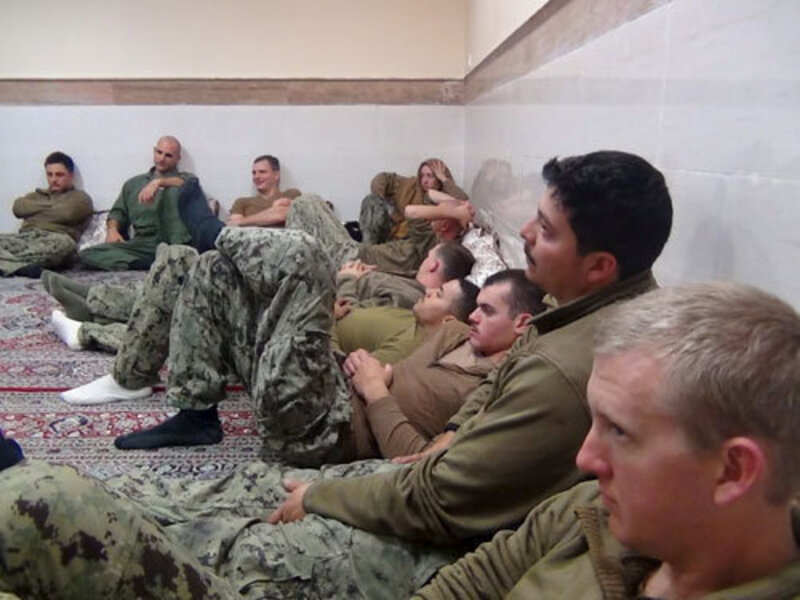Detained US soldiers revealed US sensitive information to Iranians, Navy says
Loading...
| Washington
American sailors who were detained by Iran in January gave away too much information to their captors and were seized in the Gulf following a series of missteps by the crew and their superiors, the U.S. Navy said in a report on Thursday.
The report said some of the 10 crew members, detained at gunpoint Jan. 12 by Iran's Islamic Revolutionary Guard Corps (IRGC), had revealed sensitive information, such as phone and laptop passwords, to the Iranians.
At the time of their capture, an international incident that rattled nerves days before the implementation of a nuclear accord between Iran and world powers, the sailors were in transit in two vessels from Kuwait to Bahrain.
Iran used the detentions for propaganda purposes that kept the incident in the headlines for weeks afterward.
The U.S. Navy report blamed the incident on poor planning, leaders who did not properly consider risks, and complacency amid a lack of oversight and low morale.
Navy officials sought to emphasize the corrective actions taken since the seizure at a news conference Thursday, and acknowledged that the crew and commanders had made serious mistakes.
"Our actions on that day in January and this incident did not live up to our expectations of our Navy," Chief of Naval Operations Admiral John Richardson said. "Big incidents like this are always the result of the accumulation of a number of small problems."
The report cited the instance of one crew member revealing details to the Iranian interrogators such as the top speed of his vessel and that it conducted "presence" missions.
"It is clear that some, if not all, crew members provided at least some information to interrogators beyond name, rank, service number and date of birth," the report said.
Indeed, some sailors revealed the passwords to their personal phones and laptops to the Iranians, as well as details on the capabilities of their vessels, the report said.
PROBLEMS
Problems had plagued the mission from the beginning.
The commander of the crews' task force ordered the 250-nautical-mile transit, the longest the crews had attempted, on short notice, and "severely underestimated" the transit's risks.
"He lacked a questioning attitude, failed to promote a culture of safety, and disregarded appropriate backup from his staff and subordinate commands," the report said.
The report redacted names, but the Navy last week identified the commander of the boats' task force as Captain Kyle Moses and said he had been relieved of his command.
The boats' captains and crew did not review or stick to their planned course from the moment they left port, the report said, and inadvertently went through Saudi Arabian territorial waters before entering Iranian waters off the coast of Iran's Farsi Island in the Gulf.
At one point, the crew members did not realize they were near Farsi Island because they did not zoom into their navigation system's map.
"Had any crew member zoomed into the purple dot, they would have discovered the purple dot was Farsi Island," the report said.
TAKEN AT GUNPOINT
Near the island, one of the boats suffered a faulty engine, and the two crafts were approached by two IRGC boats, which pointed their weapons. They were soon after joined by two other IRGC boats.
The boat captains did not direct their gunners to put on protective gear or to man the weapons on the boat.
Under the standard rules of engagement, U.S. military personnel are obligated to defend their units. However, in the hopes of de-escalating the situation, the captains directed their gunners to step away from their weapons.
"I didn't want to start a war with Iran," one of the boat captains told investigators. "My thought at the end of the day was that no one had to die for a misunderstanding."
The Iranians forced the sailors to remove their body armor, kneel, and place their hands behind their heads, and took video and pictures of the crew doing so. At Farsi Island, they interrogated and detained the sailors overnight before releasing them the next day.
FILMED ACTING HAPPY
The sailors also acquiesced to Iranian demands that they eat and act happy while being filmed in order to be released, and one captain read an apology prepared by the Iranians. Unbeknownst to them, the U.S. government had already negotiated their unconditional release.
In addition to Moses, in May, the U.S. Navy fired Eric Rasch, commander of the squadron that included the sailors.
The report said administrative action had been taken with regard to two personnel, and recommended action be taken regarding six others.
The report also faulted the IRGC for violating international norms. The Iranians replaced an American flag on board with an IRGC one, ransacked the vessels, and damaged equipment, the report said.
The militaries of the United States and Iran keep a close eye on each other in Gulf waters, with the U.S. naval presence there meant to reassure Gulf allies of its commitment to their security.
For Iran, which sees itself as resisting U.S. interests throughout the Middle East, the detention was a public relations coup. Iranian Supreme Leader Ali Khamenei awarded medals to IRGC commanders, and Iranian media broadcast videos of the detainees.
"This event was an act of God, it happened at a good time, and you acted admirably," Khamenei told the Iranian sailors in January. (Editing by Bernadette Baum)





